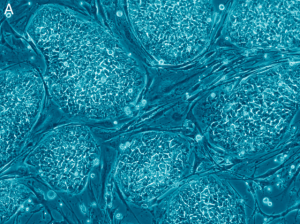Want to Live Forever? Science, Not Religion, Holds the Key to Eternal Life
 Human embryonic stem cells (CC-BY-2.5, PLoS )
Human embryonic stem cells (CC-BY-2.5, PLoS ) Ongoing stem cell research at the University at Buffalo recently resulted in a breakthrough, which could potentially lead to new clinical drugs that reverse cells’ aging process.
In a series of experiments with embryonic stem cell genes, scientists discovered that a particular gene, the Nanog gene, could actually restore the regenerative properties of old cells. As a person ages, cells slowly lose their ability to divide and replicate, the process by which new cells are born. “Cellular senescence” is the term that biologists have given to this phenomenon in which cells completely lose their ability to replicate.
Younger cells do not experience this phenomenon, because the body’s supply of adult stem cells are constantly repairing the body’s damage. However, as the body grows older, some cell pathways vital to the production of healthy adult stem cells begin to close. Gradually, the adult stem cells produced by the body become less effective at repairing and replenishing other cells. In our everyday experience, we know this process as aging.
Over time this process leads to the cell’s inability to reproduce. When enough cells experience this cellular senescence, the organs that they collectively comprise begin to decay, resulting in age-related disorders that plague the elderly, such as osteoporosis and cataracts.
The findings of the study, published in the journal Stem Cells, reveal that the embryonic gene Nanog is able to reverse cellular senescence by reopening certain cellular pathways. When this happens, the body is able to produce healthy stem cells again, which in turn are able to maintain the body’s organs as if the body were young again.
According to the University at Buffalo’s news release, Dr. Stelios T. Andreadis, the study’s lead author, thinks the process will lead to the end of aging. He stated, “Our research into Nanog is helping us to better understand the process of aging and ultimately how to reverse it.”
This news is certainly exciting, but we must take advancements cautiously and think of the unintended consequences of life extension. Dr. Peter Dirkx discussed the ethics of this issue in his talk on humanist approaches to life extension at the American Humanist Association’s 75th Anniversary Conference. He pointed out that life extension means extended morbidity, prolonged and painful deaths that add to misery of death, as well as compressed morbidity, the idea that the improving quality of life through improved health is more important than the extension of life. However, it is currently unclear whether the life extensions afforded by the Nanog gene would actually lead to extended, painful deaths. At this point, it is likely too soon to make any rash judgements that discourage further development of this innovative research.
Dirkx also emphasized the idea of rejuvenation (the repair of cellular senescence), suggesting that age-related deaths could be eliminated altogether. I predict that there will be some in religious communities who will oppose this research, claiming that by seeking to end aging, we are effectively playing God.
As humanists, we uphold humanity’s benevolence by seeking an end to our species’ suffering and pain. I would encourage humanists to embrace this new, incredible discovery and to push for its development by intelligently discussing its positive ethical implications with those who may speak out against it.
